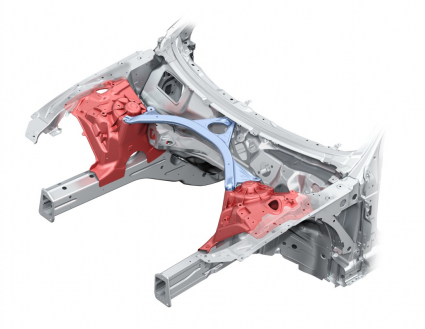Multimaterial Space Frame
Audi is taking the development of the steel body a step further – to the Multimaterial Space Frame, which combines components of aluminum, steel and fiber-reinforced polymers (FRP) with one another. The future of this new “ultra” technology has already begun with the bodies of the A7 Sportback and the new A6 (Combined fuel consumption in l/100 km: 9.6 – 4.4; Combined CO2-emissions in g/km: 225 – 114)**.
In these models the add-on parts are made of aluminum and the body shells are predominantly made of steels of different strength classes. Their structure, however, already follows the space frame principle in some areas. The rear longitudinal member of the A6 is a steel section with welded-in bulkheads. The A8 with its classic ASF uses an internally ribbed aluminum casting in this area. The properties and appearance of the two components are similar. The steel side sills of the A6 are manufactured in a rolling process and integrated into the structure in a manner similar to that used for the aluminum extruded sections in the A8.
In the A6, a node assembled from multiple high-strength steel parts serves as the connection between the A-pillar, the side sill and the front cross member. The A8 uses two aluminum diecast parts here that perform essentially the same functions. And similar to the luxury sedan, the strut mounts in the front of the A6 are complex aluminum castings. The links of the suspension are bolted directly to them; the bearing pedestals commonly used in the past have been eliminated.
Audi will systematically drive this development forward in its upcoming new models. This is the right strategy for volume production of lightweight vehicles. The mix of material fractions in the Multimaterial Space Frame offers the Audi development engineers virtually unlimited freedom. They can design each body structure optimally for the requirements. The objective is always to achieve optimum performance while using the lowest quantity of material.
The new composite body based on the “ultra” principle will enable weight reduction on a large scale. In its initial phase, it already offers the potential for reducing weight by at least 10 percent. In the future, extremely lightweight fiber-reinforced polymers (FRP) and additional new technologies will have even more significant effects. The Multimaterial Space Frame is just as light or even lighter than a comparable high-volume CFRP body. Compared with the CFRP body it provides significant advantages, not least in terms of overall energy balance and lower cost.
**Figures depend on the tires/wheels used.
Status: 2011
